
The Project Gutenberg EBook of Orchesography, by John Weaver
This eBook is for the use of anyone anywhere in the United States and most
other parts of the world at no cost and with almost no restrictions
whatsoever. You may copy it, give it away or re-use it under the terms of
the Project Gutenberg License included with this eBook or online at
www.gutenberg.org. If you are not located in the United States, you'll have
to check the laws of the country where you are located before using this ebook.
Title: Orchesography
Or, The Art of Dancing
Author: John Weaver
Release Date: October 2, 2003 [EBook #9454]
[Most recently updated: April 11, 2020]
Language: English
Character set encoding: UTF-8
*** START OF THIS PROJECT GUTENBERG EBOOK ORCHESOGRAPHY ***
Produced by Tobin Richard, Debra Storr, Greg Lindahl and
PG Distributed Proofreaders
OR, THE
BY
WHEREIN
WHEREBY
BEING
LONDON: Printed by H. Meere, at the Black Fryars, for the Author, and are to be sold by P.Valliant, French Bookseller near Catherine-Street, in the Strand. 1706.
The Service to the Lovers and Professors of this Art, having been the chief Motive of my Undertaking so difficult a Province, that we who enjoy the Happiness of so Great a Master as Mr. Isaac, should not want the Advantage of spreading that Excellence in this Art, which renders him so admir’d by all who have any Taste of it; so having receiv’d such great and generous Encouragement in this Study from you, Sir; the Product of that Encouragement and Study does, as it were, out of a natural Right and just Gratitude, seek Shelter under your Patronage, and challenge the Advantage of appearing in the World under the Protection of your Name, whole known Judgment and Mastery in this Art, will secure me from the Censure of Malice and Ignorance.
However, I shall have little to fear, if I am so happy as to merit that generous Assistance, which you have been pleased to give me in the compiling of this Book; and I am apt to flatter my self, that I have done the Original that Justice, that the Author will have no Reason to complain: But whatever Defects I may have been guilty of in it, I promise my self Forgiveness from so much Goodness and Candor, as all People (with Justice) allow to Mr. Isaac. You are so truly distinguish’d from most Men, by a peculiar Sincerity and Zeal for the Service of your Friend, or him whom you have once thought fit to espouse, that as I have done nothing but comply’d with my own Inclination, in offering this publick Acknowledgment of your Favour, so I have infinite Cause of being perfectly satisfy’d with my Patron.
I know it is the Custom of Dedicators, to launch forth into the Praises of the Virtues and Parts of their Patrons; but I know Mr. Isaac too well, to think I can render my self more acceptable to him, by entertaining him with his own Deserts, since they are too well known to all your Acquaintance, to need a Publication in this place. Not but that it would be a Theme infinitely grateful to me; but I shall curb that Inclination, and deny my self a Pleasure that would be disgustful to you. It is enough, that by spreading the Knowledge which the following Book conveys, your Excellence in the Art, your admirable Compositions will more easily, and more largely encrease the Number of your Admirers; among which, there never will be one more truly devoted to your Service, than,
SIR,
Your most Obliged Humble Servant,
John Weaver.
But notwithstanding this blind Hint of Arbeau, to do Justice to Mons. Beauchamp, we must attribute to him the Invention of this Art, who in all Probability, could no more see the former Book, than Mons. Feuillet. But as no Art was ever invented and perfected at once; so it remain’d for Mons. Feuillet, to raise the compleat and finish’d Superstructure on Mons. Beauchamp’s Foundation; and it must be allowed, that Mons. Feuillet has carry’d this Art to a very great Perfection, and taken a great deal of Pains in the Improvement of the Character, and given Rules so just, and a Method so proper, that I cannot imagine any Man can flatter himself with an Ability of designing a better, or more regular manner. For this Reason I chose rather to follow his Method entirely, than attempt any Alteration of my own, which I have done with that Care and Diligence, that I think I may assure the Reader I have omitted nothing that he has deliver’d. I have also made it my Business to bring the Reader acquainted with the Meaning of my Author, as well as his Words, which is a Happiness every Translator has not the Power of arriving at, as generally either ignorant of the Subject or Language he translates from, or into, or both.
Another Fault of our common Translators I have avoided with all the Industry I could: Some of them pretending to meddle with Books of Art, and not understanding the Terms of Art, give us such an odd Jargon, that we can never understand it without the Interpretation of a Master, or having Recourse to the Original itself. I have therefore render’d all the French Terms into English, but with so much Caution of doing Justice to the Author, and the Art, that I would not defend on my own Judgment, but let none pass without the Approbation of the best English Masters.
The Perfection, which Dancing is now come to in England, seems to point this Time out at the fittest Juncture, for the Publication of a Book of this Nature; since we now enjoy in this Nation, Performers and Masters of greater Excellence than any other part of Europe; who shew every Beauty of the Art in its full Glory and Perfection. For whoever shall consider the Masterly Compositions of Ball-Dances by Mr. Isaac, which are so well adapted to the manner of our School-teaching, (peculiar to England, no other Nation having any such thing as publick Dancing-Schools) whoever shall see the admirable Compositions of Mons. L’Abbé in Ballet, and his Performance, with that of M. Desbargues, M. Du Ruel, and M. Cherrier, can hope to see nothing in this Art of greater Excellence, unless any wonderful Genius should arise, and advance this once celebrated Art to that Perfection, which drew the Eyes, and employ’d the Pens of the old Greeks and Romans; a lively Description of which, the Reader may see in this Epigram, by an unknown Hand
Mascula foemineo derivans Pectora Sexu,From this Epigram, it is plain, that the ancient Dancing had something more than Motion, Measure, and Figure, and express’d the Passions and Actions of Mankind, was a sort os silent Poetry, and the Painting, tho’ without Colours, so expressive, as to touch and charm every Beholder.
Atq; aptans lentum Sexum at utrumq; latus,
Egressus Scenam Populum faltator adorat
Solerti pendet predere verba Manu.
Nam cum grata Chorus diffundit cantica dulcis
Quæ resonat Cantor, motibus ipse probat.
Pugnat, ludit, amat, Bacchatur, Vertitur, adstat,
Illustrat verum, cuncta decore replet.
Tot Linguæ, quot Membra viro, Mirabilis est Ars,
Quæ facit Articulos voce silente loqui.
There will be no need to enforce the Use of this Art, and by Consequence recommend the Book that teaches it, to all Lovers of Dancing, since it carries its own Evidence with it self, and has already convinc’d them of its Benefit and Advantage; and I question not but others will find the same Satisfaction from their Study, which I have done, since by a close Application to this Character, I have made such a Progress in it, as to be able to communicate all Dances to the rest of the Profession at any Distance. I have a great deal of Reason to believe, that had not I first undertaken to make Mons.Feuillet speak English, this Character had yet a longer while remain’d a Secret to this Nation; those who had made their private Market of it, not being willing to admit any Rivals in an Art, which chiefly distinguish’d them from others of their Profession.
I must undeceive some, who may perhaps mistake the Design of the following Treatise, and take it for an Instruction, or some Improvement in the Art of Dancing, or Method of Teaching. But I must assure them, that I am not yet Master of Vanity enough to venture upon a Task so difficult, and so invidious, since I am of Opinion, that there are not better Masters for instructing Scholars in a genteel Movement and Address, than the English.
I shall not therefore detain the Reader any longer in the Porch, but leave him now to enter, and improve.
Ingredere ut proficias.
| A Monsieur L’Abbé. B C D E G |
H Mr. Walter Holt, Sen. Mr. Walter Holt, Jun. Mr. Rich. Holt. Mr. Heale of Salisbury. I L N O P R S |
This Undertaking bas also been encouraged by the Subscriptions of several of the Nobility and Gentry
OR,
BY
The Explanation of the Terms belonging to DANCING, seem to be altogether needless, since they are so plain and intelligible of themselves: But lest the Reader should put wrong Constructions on those Terms of Art which the Dancing-Masters make use of, I shall give the following Explanation of them.
Dancing is composed of Positions, Steps, Sinkings, Risings, Springings, Capers, Fallings, Slidings, Turnings of the Body, Cadence or Time, Figures, &c.
Positions, are the different Placings of the Feet in Dancing.
Steps, are the Motions of the Feet from one place to another.
Sinkings, are the Bendings of the Knees.
Risings, are when we rise from a Sink, or erect our selves.
Springing, is a rising or leaping from the Ground.
Capers, are when in rising or leaping from the Ground, one Leg beats against the other, which we call Cutting.
Fallings, are when the Body, being out of its proper Poise, falls by its own Weight.
Slidings, are when, in moving, the Foot slides on the Ground.
Turnings, are when the Body turns either one way or the other.
Cadence or Time, is a right understanding of the different Measures, and Observation of the most remarkable places in the Tune.
Figures, are Tracts made by Art, on which the Dancer is to move.
Before I proceed to demonstrate what I have already explain’d, I shall describe the Room or Stage, where Dancing is perform’d; as also the different Tracts or Figures to be made thereon, and the Posture and Presence of the Body, in which the Performer ought to stand.


| The Face of Forepart of the Body up. | The Face down. | The Face to the right side. | The Face to the left side. |
 |
 |
 |
 |
Which Tract serves for two Ends, the first to direct the Steps and Positions, and the other to represent the Figure of the Dance.
All Steps and Positions may be described upon two Lines, viz.upon a Right Line, and a Diametrical Line; but because the Tract must also be made use of for the Explanation of the Figure of Dances, I shall add to these Lines, the Circular and i>Oblique.
A Right Line, I call that which extends it self in Length, from one end of the Room to the other, as by the Line mark’d K.
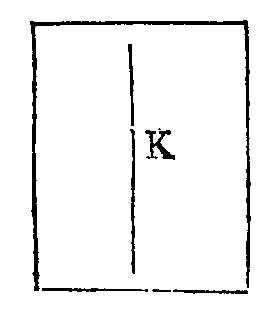
A Diametrical Line, is that which goes cross the Room from side to side, as is shewn by the Line L.
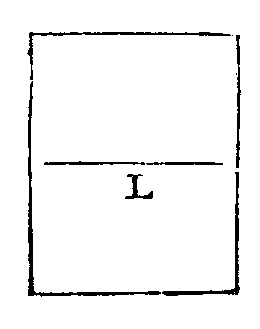
The Circular Line,
is that which goes round the Room, as is express’d by the Letter
M.

The Oblique Line, is that which goes cross the Room, from Corner to Corner, as may be seen by the Line N.

Every one of these Lines, or Tracts, may jointly
or separately form the Figure of a Dance, on which may be
described the Positions and Steps, as in Figure O.
The beginning of which Tract, is shewn by the Character representing
the Posture or Presence of the Body, which must be join’d
to it, to shew the Position of the Body at the beginning of the
Dance.

The True, are when the Feet are plac’d uniform, and have the Toes turn’d out equally.
The False, are some of them uniform, others not, and differ from the True, in that, the Toes are turn’d inward, or one in, and the other out.
In all Positions whatsoever, the Form of the Foot is known by these Marks, viz. That which resembles an O, represents the Heel; the Line join’d to it, the Ankle; and the Extremity of that Line, the Point of that Foot.
A half Position.
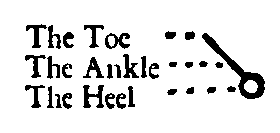
This Figure of the Foot, is but a half Position, because
it represents but one Foot, whereas a whole Position does
that of two, as in the Figure A B.
Position

’Tis to be observ’d, that the Letter A, in the foregoing Figure, represents
the left Foot, and B, the right.
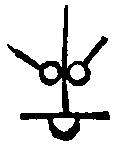
The second is when the Feet are open, or separate, on a Line, one distant from the other the length of the Foot. Second Position.

The third is when the Heel of one Foot is join’d to the Ankle of the other, which I shall hereafter term inclos’d. Third Position.

The fourth is when the two Feet are plac’d one before the other, the distance of a Foot in length. Fourth Position.

The fifth is when the two Feet are cross’d, the Heel of one directly opposite to the Toe of the other. Fifth Position.


The second is when the Toes are turn’d inwards, there being the distance of a Foot’s Length between the Toes; the Heels as before. Second Position.

The third is when the Toe of one Foot is outwards, and the other inwards, the one parallel towards the other. Third Position.

The fourth is when the Toes are turn’d inwards, so that the Toe of one Foot points to the Ankle of the other. Fourth Position.

The fifth false Position, is mark’d like the fifth true one, and seems to be the same Position; but notwithstanding, they are very different, for whereas in the true one, the Toes are turn’d outwards, in the false, they are turn’d inwards, crossing each other, so that the Heel of one Foot is right against the Toe of the other, and is to be distinguish’d from the true one by a small Bar between the Position. Fifth Position.

A straight Step, is when the Foot moves in a right Line; which is to be made two ways, forwards, and backwards.
The open Step, is when the Leg opens; which is to be done three ways, one outwards, another inwards, both which make an Arch or half Circle, and the third sideways, which may also be called a straight Step, because the Motion of it is in a direct Line.
The round or circular Step, is when the Foot, in moving, makes a circular Figure; of this there is two ways, one outwards, and another inwards.
The waving Step, is when the Foot, in moving, turns both inwards and outwards. There are three ways of doing this, forwards, backwards, and sideways.
The beaten Step, is when one Leg or Foot is beaten against the other. Of this there are also three ways of performing, viz. forwards, backwards, and sideways.
A Step is known by the Character following, viz. a black Spot mark’d A, representing the Position of the Foot, the Line drawn from that Spot, mark’d B, shewing the Motion, Figure, and Largness of the Step, as from A to D, and lastly, by a small side Stroke join’d to the End of the Line C, representing the Foot, of which D is the Heel, and E the Point of the Foot, or Toe.

| A straight Step forwards.
|
The same backwards.
|
An open Step outwards.
 |
The same inwards.
 |
The same sideways.
|
A circular Step outwards.
 |
The same inwards.
 |
| A waving Step forwards.
|
The same backwards.
|
The same sideways.
|
| A beaten Step forwards.
|
The same backwards.
 |
The same sideways.
|
To a Step may be added these following Marks, viz. Sinking, Rising, Springing or Bounds, Capers, Falling, Sliding, holding the Foot up, Pointing the Toes, placing the Heel, turning a quarter Turn, a half Turn, a three quarter Turn, and a whole Turn.
The Mark for a Sink, is a little Stroke inclining towards the little black Head.
A Sink.
![]()
The Mark for a Rise from a Sink, is when there is a little straight Stroke upon the Step.
A Rise.
![]()
The Mark of a Spring or Rise from the Ground, is when there are two of the aforesaid Strokes, which is sometimes call’d a Bound.
A Spring, or Bound.
![]()
The Mark for a Caper, is when there are three Strokes.
A Caper.
![]()
The Mark for a Falling Step, is when at the End of the little straight Stroke, another straight one is join’d parallel to the Step, and pointing to the Mark for the Foot.
A falling Step.
![]()
The Mark of a Slide, is when at the End of the little Stroke, a small Bar is plac’d parallel to the Step.
A Slide.
![]()
The Mark for the Foot up, is when the Step is cut off.
The Foot up.
![]()
The Mark for pointing the Foot, without the Body’s bearing upon it, is when there is a Point directly at the End of that which represents the Toe.
To point the Foot.
![]()
The Mark for placing the Heel, without the Body’s bearing upon it, is when there is a Point directly behind that which represents the Heel.
To place the Heel.
![]()
A quarter Turn of the Body, is shewn by a quarter of a Circle plac’d on the Step.
A quarter Turn.
![]()
A half Turn, is represented by a half Circle.
A half Turn.

A three quarter Turn, is shewn by a three quarter Circle.
A three quarter Turn.

A whole Turn, is represented bya whole Circle.
A whole Turn.

| Sink and Rise. | Rise and Sink. | Sink and Bound. | Bound and Sink. | Sink, Bound and Sink. | Sink and Caper. |
| Rise and Fall. | Sink, Rise and Slide. | Sink and Hop. | Sink, Bound and Turn. | Sink, Rise, and point the Toe. | Sink, Bound, & place the Heel. |
 |
 |
 |
 |
 |
 |
When there is the Mark of a Sink at the beginning of a Step, the Sink must be made before the Foot moves.
Sink before the
Foot moves.
![]()
When the Sink is mark’d in the middle of the Step, the Sink is not to be made till the Foot has made half the Step.
A Sink
in moving.
![]()
When the Sink is mark’d at the end of the Step, the Sink must not be made till the Step is finish’d.
A Sink after Movement.
![]()
It is the same thing in the Marks of a Rise.
| Rise before the Foot moves.
|
Rise in moving.
|
Rise after Movement.
|
| Sink and Rise before the Foot moves.
|
Sink and Rise in moving.
|
Sink and Rise after moving.
|
| Sink before Moving, and Rise in Moving.
|
Sink as before, and Rise after Moving.
|
Sink in Moving, Rise after the Movement.
|
The Springings which are made on both Feet, are mark’d upon the Positions, as hereafter will appear; whereas the Springings that are made in moving, are mark’d upon the Steps, as has been already shewn, and will again appear by the Sequel.
When there is a Mark of a Spring upon the Step, and no Mark for the holding up of the Foot after it, it shews, that the Spring is to be made with the Foot that moves, which is call’d a Bound
A Bound.
![]()
But when there is a Mark for a Spring, and afterwards a Mark for the Foot up, it signifies, that the Spring must be made on the Foot that does not move forwards, which is call’d a Hop.
A Hop.
![]()
The mark for falling, has no proper Place assign’d it, and I shall only observe, that in rising, when it is in Order to fall, it is necessary the Mark for a Rise, should be near the beginning of the Step.
Rise and Fall.
![]()
The mark for a Slide, has likewise no proper Place, when it is single on a Step; but when it is accompanied with other Marks, as sinking, rising, &c. then it must be plac’d last.
Sink, Rise, and Slide.
![]()
If after the Mark of a Slide, there be also the Mark for the Foot up, you must Slide no farther than that Mark shewing the Foot up.
Slide, and afterwards hold the Foot up.
![]()
The Mark for the Foot up, may be plac’d either in the Middle, or the End; when it is in the Middle, it shews, that the Foot is only up, in Order to be set down afterwards.
Foot up, and then put down.
![]()
But when it is at the End, it signifies, that the Foot must remain up.
Foot up.
![]()
To point the Toe, and afterwards the Heel, there must be a Point on the outside of that which represents the Toe, and another on the inside of that which represents the Heel.
To point the
Toe, and after to place the Heel.
![]()
To place the Heel, and afterwards point the Toe, there must be a point on the outside of that which represents the Heel, and another on the inside of that which represents the Toe.
To
place the Heel, and afterwards point the Toe.
![]()
It is to be observed, that in the two foregoing Examples, the Point which is on the Outside of that which represents either the Toe or Heel, is the Point from whence you must always begin.
When there is a Point at the end of that which represents the Toe, and another behind that which shews the Heel, it shews, that the Foot must be set down flat.
A flat Foot.
![]()
Marks for Turning, have no proper Places assign’d them, no more than the falling or sliding Mark ; but you must then observe to which side to turn, whether to the right or left.
You must observe, that the beginning of the turning Mark, is to be taken from that Part which is nearest to the black Spot.
After having thus shewn the beginning of each turning Mark, you must observe exactly which way to turn, whether to the right or left, as appears by the following Examples:
| A quarter turn to the Right.
|
A quarter Turn to the Left.
|
A half Turn to the Right.
 |
A half Turn to the Left.
|
Three quarter Turn to the Right.
 |
Three quarter Turn to the Left.
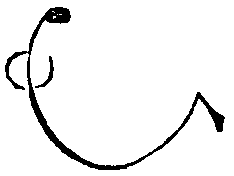 |
The beginning of a whole Turn, or turn quite round, is more difficult to find out, because the Circle, which is the Mark of it, has neither beginning nor End: But it is nevertheless to be known by a Point plac’d on the side of the Step; from which Point the beginning being known, you make Use of the same Rules as above.
A whole Turn to the Right.
 |
A whole Turn to the Left.
 |
A half quarter Turn to the Left.
 |
A half quarter Turn to the Right.
 |
To bear the Body on the Toe.
 |
To bear the Body on the Heel.
 |
When there is a Point at the end of the sinking Mark, it shews, that the Toe must be bent downwards.
Sink, the Toe towards the
Ground.
![]()
When there is a Point behind the sinking Mark, it denotes, that the Heel must be bent downwards.
Sink, the Heel towards the Ground.
![]()
When there is a Point at the end of the sinking Mark, and another behind, it shews the Sink must be with a flat Foot.
Sink, the
Foot flat.
![]()
When there is a Point at the end of a rising Mark, it shews the Rise must be made on the Toe.
Rise on the Toe.
![]()
When there is a Point behind the rising Mark, it shews, that the Rise must be made on the Heel.
Rise on the Heel.
![]()
When there is a Point at the end of a rising Mark, and another behind, it shews, that the Rise must be on a flat Foot.
Rise on
a flat Foot.
![]()
When there is a Point at the end of a springing Mark, it shews, that the Spring, Hop, or Bound, must be made on the Toe.
Spring
on the Toe.
![]()
When there is a Point behind the springing Mark, it shews, that the Spring, Hop, or Bound, must be made on the Heel.
Spring
on the Heel.
![]()
When there is a Point at the end of the springing Mark, and another behind, it signifies, that the Spring, Hop, or Bound, must be made on a flat Foot.
Spring on a flat Foot.
![]()
When there is a Point at the end of the sliding Mark, towards the Mark representing the Foot, it shews, that the Slide must be made on the Toe.
Slide on the Toe.
![]()
When there is a Point at the other end of the sliding Mark, it shews, that the Slide is to be made on the Heel.
Slide on the
Heel.
![]()
And when there is a Point at each end of the sliding Mark, it denotes, that the Slide must be made with a flat Foot.
Slide
with a flat Foot.
![]()
If there were, for Example, a sinking Mark upon a half Position, it would shew, that the Knee of that Leg only was to be bent; but if sinking Marks should be on the whole Position, then both Knees are to be bent at the same time. The same is to be observ’d for Rising, Springing, &c. The Marks on the Positions, have no appointed Place, as they have on Steps, excepting Points, which are to be plac’d in the same manner as on Steps.
Sink on one Foot.
 |
Sink on both Feet.
 |
Rise on one Foot.
 |
Rise on both Feet.
 |
Spring on one Foot.
 |
Spring on both Feet.
 |
Caper on one Foot.
 |
Caper on both Feet.
 |
One Foot up.
 |
Foot up, and then down.
 |
To point the Toe.
 |
To be on both Toes.
 |
To place the Heel.
 |
To be on both Heels.
 |
To point the Toe, and then the Heel.
 |
To be first on the Toes, and then the Heels.
 |
To place the Heel, and point the Toe.
|
To be first on the Heels, and then the Toes.
 |
To be on the flat Foot.
 |
Both Feet flat.
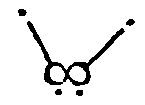 |
A Turn on the Foot to the Rise.
 |
A Turn on both Feet to the Rise.
 |
Turn on one Foot to the Left.
 |
Turn on both Feet to the Left.
 |
Sink, and rise on one Foot.
 |
Sink, and rise on both Feet.
 |
Rise, and sink on one Foot.
 |
Rise, and sink on both Feet.
 |
Sink, and spring on one Foot.
 |
Sink, and spring on both Feet.
 |
Spring, and sink on one Foot.
 |
Spring, and sink on both Feet.
 |
Sink, spring, and sink on one Foot.
 |
Sink, spring, and sink on both Feet.
 |
Sink, and caper on one Foot.
 |
Sink, and caper on both Feet.
 |
Sink, and spring a half Turn to the Left on one Foot.
 |
The same on both Feet.
 |
Sink, caper a three quarter Turn to the Right on one
Foot.
 |
Sink, caper on both Feet a whole Turn to the Right.
 |
Turn on the Toes a half Turn to the Left.
 |
The same on the Heels.
 |
Sink, rise, and turn a half Turn on the Toes to the
Right.
 |
The same on the Heels.
 |
All the Marks of sinking and rising, which have been already demonstrated upon the Step, have Relation to the Bendings and Risings of both the Knees: But when it shall happen, that in moving in a Dance, one Knee only ought to bend or rise, the following Rules must be observed.
It will be necessary upon this Occasion, to understand when one Leg moves, what the other ought to do; to demonstrate which, I shall make use of a half Position and a Step, which must be ty’d together by a Small Line, of which, one end is join’d to that which represents the Heel of the half Position, and the other to the Head of the Step. This Union denotes, that the half Position and the Step, are both to act at the same time.
| To bend the left Knee, while the right moves extended.
|
To bend, and rise the left Knee, while the right moves
extended.
|
To bend the left Knee, moving the right half way extended
and afterwards to bend in moving.
 |
To bend the left Knee, the right moving extended, and
sink in the middle of the Step, and rise on the Toes.
 |
To bend the right Knee in moving, and rise towards
the end, the left continuing extended.
 |
Two Steps ty’d together at the Heads, shew they are both to move at once, which can only be perform’d by springing, which I shall hereafter call a starting Step.
These kind of starting Steps, may be practis’d two ways, viz. with both Knees stiff, or falling with the Knees bent.
The first of these needs no other Mark for Direction, but the sliding Mark; but the other must have the sliding and falling Marks together.
To Spring with both Feet open at once.
 |
With one Foot forwards, and the other backwards, both
at once.
 |
A starting Step, with both Feet open, the Knees stiff.
 |
A starting Step, one Foot forwards, the other backwards,
the Knees stiff.
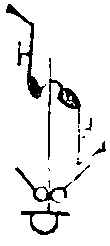 |
A starting Step, with both Feet open, and falling with
both Knees bent.
 |
The same, one Foot backwards, the other forwards.
 |
Waving on the Toe, the Heel opening outwards.
 |
The same on both Toes.
 |
Waving on the Heel, the Toe closing inwards.
 |
The same on both Heels.
 |
Waving with the Foot up, the Toe closing inwards.
 |
Waving and unwaving, the Heel opening outwards, and
then closing inwards.
 |
The same with both Feet.
|
Waving and unwaving, the Toe closing, inwards, and
afterwards opening outwards.
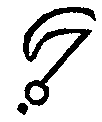 |
The same with both Feet.
|
Waving and unwaving with the Foot up, the Toe closing
inwards, and then opening outwards.
 |
Examples of waving Positions, where the Toes or Heels wave both one way, and are distinguish’d by the Crescents being both on the same side.
Waving on both Toes, the Heels moving to the Right.
 |
The same to the Left.
 |
Waving on both Heels, the Toes moving to the Left.
 |
The same to the Right.
 |
Examples of waving and unwaving Positions, where the Feet turn and return both on the same side.
To turn on the Toes, the two Heels moving to the Right,
and returning to the Left.
 |
The same to the Left, and to tht Right.
 |
To turn on the two Heels, the Toes moving to the Left,
and then returning to the Right.
 |
The same to the Right, and to the Left.
 |
The Change of Positions is made two ways, either by springing, or waving.
Those which are perform’d by springing, are done when you spring from one Position, and fall in another; and those which are perform’d by waving, must be done on the Ground, by waving the two Feet, or each Foot Separately, either on the Toes or Heels.
The shifting of Positions by springing, may be known by
what follows, viz. by two Positions, one of which has springing
on it, and the other none.
a TABLE of the shifting of the True Positions |
a TABLE of the shifting of the False Positions |
||
from the 1st to the 2nd.
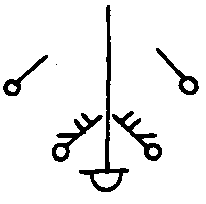 |
from the 1st to the 3rd.
 |
from the 1st to the 2nd.
 |
from the 1st to the 3rd.
 |
from the 1st to the 4th.
 |
from the 1st to the 5th.
 |
from the 1st to the 4th.
 |
from the 1st to the 5th.
 |
from the 2nd to the 3rd.
 |
from the 3rd to the 5th.
|
from the 2nd to the 3rd.
 |
from the 3rd to the 1st.
 |
from the 4th to the 2nd.
 |
from the 5th to the 1st.
 |
from the 4th to the 2nd.
 |
from the 5th to the 4th.
 |
| from the 4th to the 4th.
|
from the 3rd to the 3rd.
 |
from the 3rd to the 3rd.
 |
from the 4th to the 4th.
|
a TABLE of the Changing true positions into false positions |
a TABLE of Shifting from false positions to true positions |
||
from the 1st true to the 2nd false.
 |
from the 1st true to the 3rd false.
 |
from the 1st false to the 2nd true.
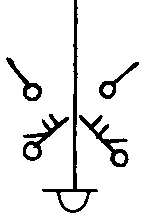 |
from the 1st false to the 3rd true.
 |
from the 1st true to the 4th false.
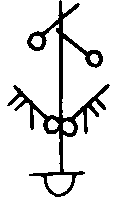 |
from the 1st true to the 5th false.
 |
from the 1st false to the 4th true.
 |
from the 1st false to the 5th true.
 |
from the 2nd true to the 3rd false.
 |
from the 3rd true to the 1st false.
 |
from the 2nd false to the 3rd true.
 |
from the 3rd false to the 4th true.
 |
| from the 4th true to the 5th false.
|
from the 5th true to the 2nd false.
 |
from the 4th false to the 1st true.
 |
from the 5th false to the 2nd true.
 |
from the 1st true to the 1st false.
 |
from the 3rd true to the 3rd false.
 &c &c |
from the 2nd false to the 2nd true.
 |
from the 3rd false to the 3rd true.
 |
To spring forwards, both feet join’d.
 |
The same backwards.
 |
To spring forwards, separating the Feet.
 |
The same backwards.
 |
To spring forwards, and fall inclosed.
 |
The same backwards
 |
To spring sideways to the Right, join’d.
 |
The same to the Left.
 |
To spring sideways to the Right, cross’d.
 |
The same to the Left.
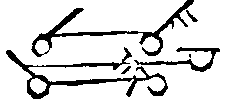 |
To spring sideways cross’d to the right, the foremost
Foot falling behind.
 |
The same to the Left
 |
Positions may also change in springing, by two Steps being ty’d together at the Heads; which shews, that they must move both at the same time.
A Spring forwards, with both Feet join’d.
 |
The same backwards.
|
To spring from the first Position to the second.
 |
To spring from the second to the first.
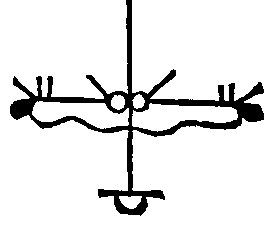 |
I have already said, that one Position may change to another, by waving both Feet at once, or separately.
Those which are to be made with both Feet at once, are to be known by
a wav’d Position; and those which are to be made by one Foot only,
are known by a half Position wav’d.
The Changing of Waving Positions. |
|||
from the 1st true to the 2d false
 |
from the 2d false to the 1st true
 |
from the 1st false to the 2d true
 |
from the 2d true to the 1st false
 |
from the 3d true to the 2d false
 |
from the 2d false to the 3d true
 |
from the 3d true to the 3d false
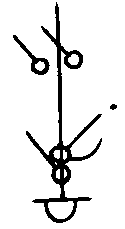 |
from the 3d false to the 2d true
 |
from the 2d true to the 3d false
 |
from the 3 false to the 3d true
 |
from the 3d false to the 3d false
 |
from the 3d false to the 3d false
 |
from the 5th true to the 4th false
 |
from the 4th false to the 5th true
 |
from the 1st true to the 1st false
 |
from the 1st false to the 1st true
 |

You must observe always to hold the upper end of the Book against the upper end of the Room; and whether the Dance have any Turning in it or not, you must carefully avoid removing the Book from the Scituation above demonstrated.
When any Steps are made without turning, or in turning quite round, then both sides of the Book must be held with both Hands; but in turning a quarter round, half round, or three quarters round, it will be necessary to take more Care, because it will be difficult to turn, unles the Book turns also; yet this must be absolutely avoided; for if the Book moves out of its Scituation, it will be impossible to comprehend the Steps therein describ’d; wherefore, for the better Observation of this, I shall give you the following Rules.
After having consider’d the Turning, and on what side to turn, as for Example, in a quarter Turn to the Right, you must put your left Hand to the farther part of the Book, and your Right to the nearest. Your Hands being thus prepared, in turning your quarter Turn, bring your left Hand in to you, whilst your right removes from you; so that both Hands will by this means be equally advanc’d before you, holding the Book by the same places before-mention’d, and you will find, that in turning a quarter round, the Book will still remain in its former Scituation. You must make use of the same Rule in a half Turn.
I shall only add, that the Hand, which is plac’d on the most opposite part of the Book, must come quite in to your Breast, while the other removes quite from you.
To turn three quarters round to the Right, you must cross your Hands more than you did in the half Turn; so that your left Hand must hold the upper part of that side which your right Hand would naturally have held, had you not turn’d; and your right Hand must hold the lower part of that side, which your left would otherwise have held. Your Hands being thus prepar’d, you will turn three quarters round in the same manner as you did half round.
The same Rules may be made use of in turning to the left, only you must observe, that instead of placing your left Hand, you must place the right to that part of the Book the farthest from you; and it may serve for a general Rule, that in turning to the Right, you first remove your left Hand; and in turning to the Left, you remove your Right.
Examples.
To move round.
 |
To move forwards.
 |
To move sideways.
 |
To move backwards
 |
The Steps and half Positions, which are on the right side, are made with the right Foot; and those which are on the left side, with the left Foot, as the following Movements will demonstrate, where I shall give to each Step and half Position, the same Letters r and l, the better to explain them.
Besides the Letters, r and l, the Step and half Position of the right or left Foot, will be easily known, by observing which way the Toes are turn’d.
The Toe turning outwards on the right side, is the right Foot, and the Toe turning outwards on the left side, is the left.
The different Tracts or Figures made in Dancing, whether forwards, backwards, sideways, or round, will be explain’d by what follows.
The Tract mark’d A, is moving forwards, the Face towards the upper end of the Room.
The Tract B retires or goes back, the Face towards the lower end of the Room.
The Tract F is moving forwards, the Face towards the right side of the Room.
The Tract H retires, the Face towards the left side of the Room.
The Tract I, moves forwards, the Face towards the left side of the Room.
The Tract K retires backwards, the Face towards the right side of the Room.
The Tracts G, move round, and the Tracts M, retire round.
>
In moving sideways, the Tract or Line must also be considered as to its two sides, viz. the upper side mark’d X, and the under side mark’d Y. Steps and half Positions, which are on the upper side of the Line, are to be made with the foremost Foot, and those which are on the under side, with the hinder Foot.
The Tracts mark’d N, are moving sideways to the right, towards the lower end of the Room.
The Tracts R, move round sideways to the right.
And the Tracts S, move round sideways to the left.
To move the right Foot sidesway.
 |
To move the left Foot sideways.
 |
A Step, which is to cross behind the foregoing Step, must begin above the Line, and descend obliquely below it; and which you will easily understand by the following Example: The first Step you may know by Number 1, and the other, which crosses, by Number 2.
To move the right Foot sideways, and cross the left
behind.
 |
To move the left Foot Sideways, and cross the right
behind.
 |
A Step, which begins with the foremost Foot, in order to move sideways, to end on a Line with the other Foot, ought to begin from the part above the Line, and descend obliquely sideways towards that below, as the following Step, mark’d Number 1, will shew.
To move the right Foot sideways.
 |
To move the left Foot sideways.
 |
A Step, which is to cross before the foregoing Step, must begin from below the Line, and rise obliquely above it, which you may observe by the Step Number 1.
To move the right Foot sideways and cross the left
before.
 |
To move the left Foot sideways, and cross the right
before.
 |

The same thing must be observ’d in moving several times round on the same Circle, as upon the Circle mark’d D; about which may be describ’d as many Circles as shall be necessary. As for Example, the Circles E and F, which must be supposed to be on the same Circle with the Circle D.

Steps which move forwards or backwards, shall be taken to be in the fourth Position.
Steps which move streight, opening sideways, shall be taken to be in Second the Position, and Steps crossing, whether forwards or backwards, shall be taken to be in the fifth Position.
To move to the fourth Position, and afterwards to the
second.
 |
To move to the fifth Position, and afterwards to the
second.
 |
To move to the fifth Position, and afterwards to the
fourth.
 |
To move to the fifth Position, and afterwards to the
second.
 |
To move to the second Position, and afterwards to the
fifth.
 |
To move to the second Position, and afterwards to the
fifth.
 |
If it should happen nevertheless, that any of the above-mention’d Steps should terminate upon both Feet, as it often happens in rising and springing, it is then necessary to mark the Position; without which it would be impossible to know, that the rising and springing should be on both Feet; wherefore, in demonstrating the Positions of join’d and inclos’d Steps, I will add to them those before-mention’d, on which I will also mark the Positions, to make Use of on Occasion.
A Step to the first Position forwards.
 |
The same backwards.
 |
A Step to the third Position forwards.
 |
The same backwards.
 |
A Step to the third Position before.
 |
The same behind.
 |
A rising Step on both Feet in the Second Postion.
 |
A Spring on both Feet in the Second Postion.
 |
A Rise on both Feet in the fourth Position.
 |
A Spring on both Feet in the fourth Position.
 |
A Rise on both Feet in the fifth Position.
 |
A Spring on both Feet in the fifth Position.
 |
A Position at the end of a Step, may be also known by adding to the Step a half Position, because the Representation of the Foot, which is at the Extremity of the Step, is made Use of, upon this Occasion, for a half Position; and a half Position join’d to it, is the same as a whole Position.
A join’d Step.
 |
An inclos’d Step.
 |
The Same Rule must be observ’d in beaten Steps, viz. That the half Position represents the Foot, against which the other beats; and whereby you may know whether the Beat be made on the Instep, behind the Heel, against the Ankle, or against the side of the Foot.
A Beat on the Instep.
 |
A Beat behind.
 |
A Beat on the Instep, and a move behind.
 |
A Beat behind and before.
 |
A Beat above and below.
 |
The same four times.
 |
A Beat on the Ankle.
 |
A beat 4 times on the Ankle, & behind the Heel.
 |
A Beat sidewards, moving forwards.
 |
The same backwards.
 |
The same twice, moving forwards.
 |
The same, moving backwards.
 |
You must observe, that when two Steps terminate both in the same Position, the first moves without any regard to the Position, and it is the last only that must observe the said Position; as the following Examples will demonstrate.
To move the right Foot forwards, and join the left.
 |
To move the right Foot forwards, and inclose in the
left behind.
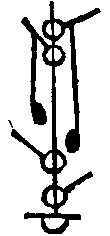 |
A simple Step, is that which is alone, as all those which hitherto demonstrated; and a compound Step, is, where two or more Steps are join’d together by a Line, and which then are to be reputed as one Step only, as will appear by the following Steps.

To practise more easily what has already been taught and demonstrated, you may make Use of the following Tables; where you will find all or the greatest Part of the Steps us’d in Dancing, whether with one Foot, or the other, forwards, backwards, sideways, or turning, as well upon streight Lines, as diametrical.
You must observe, that each Square contains only one Step, which I have writ down twice, to the end to shew, that what is perform’d with one Foot, may also be perform’d with the other.
An Explanation of the Steps contain’d in each Square, is also writ down with them; and whereas some of the Words and Terms are abbreviated for want of Room, I have put down here a short Explanation of them.
| forw.----------------------forwards.
bacw.-------------------backwards. sidw.-----------------------sideways. sl.--------------------------------slide. cro.---------------------------cross’d. op.-------------------------------open. qr.-------------------- quarter Turn. hf.------------------------- half Turn. 3 qr. Turn----three quarter Turn. |
circ.-------------------circular.
jo.-----------------------join’d. incl.-------------------inclos’d. bef.---------------------before. beh.--------------------behind. wav.------------------waving. turn.------------------turning. outw.---------------outwards. inw.-------------------inwards. |
a TABLE of half Coupees |
|
Half Coupee forwards
  |
Backwards
  |
Open backwards
  |
the same
|
the same circular before
  |
the same circular sideways
  |
| open sideways
|
another
 |
another
 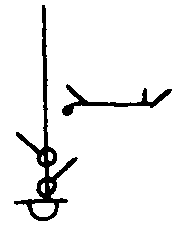 |
crossways before
 |
TABLE of half Coupees |
|
another
  |
the same
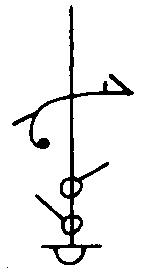  |
Crossing behind
 |
the same
  |
Forwards joyn’d on the end of the feet
  |
the same backwards
  |
Forwards inclosed
  |
the same backwards
  |
Forwards joyn’d the 2nd foot up
  |
the same backwards
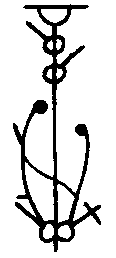  |
Forwards inclosed 2nd up
  |
the same backwards
  |
TABLE of half Coupees |
|
| Sideways open and joyn’d 2nd up
|
another
 |
| another
|
another
|
another
 |
another the last inclosed behind
|
a beat behind
  |
the same
 |
Beat before cross the ankle
 |
the same
 |
Sideways open
  |
the same
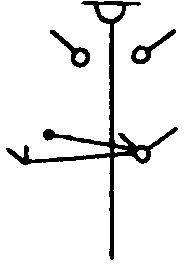  |
TABLE of half Coupees |
|
Beat on the ankle open sideways
  |
the same
  |
crossing forwards quarter turn
 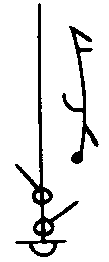 |
open sided quarter turn
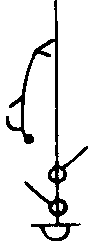  |
the same
 |
another
  |
another
 |
the same
 |
Forwards turning quarter
 |
the same
 |
| another
|
another
|
TABLE of half Coupees. |
|
Backwards turning
 |
open half turn
  |
Forwards turning
 |
Open turning
|
the same
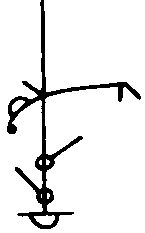  |
Beat on the ankle turn open to the side
  |
another
 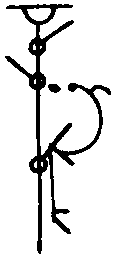 |
Beat behind turning
  |
another
  |
Open side turning
 |
| the same
|
Forwards turning
 |
TABLE of Coupees |
|
the same
 |
Backwards; 2nd beat before and fall behind
 |
Backwards: 2nd beat before and inclosed behind
 |
the same
 |
2nd inclosed behind
 |
the same
 |
the same
 |
Both inclosed behind
 |
Crossed behind; 2nd open sideways
 |
Circular before crossed behind: 2nd open up
 |
Circular behind 2nd joyned
 |
Backwards inclosed 2nd step forwards
 |
TABLE of Coupees |
|
Inclosed before 2nd step backward
 |
Open sideways 2nd crossed before
|
| Another behind
|
Another 2nd open and fall behind
 |
Another 2nd passing before to open outwards
 |
the same
 |
Open both
 |
the same
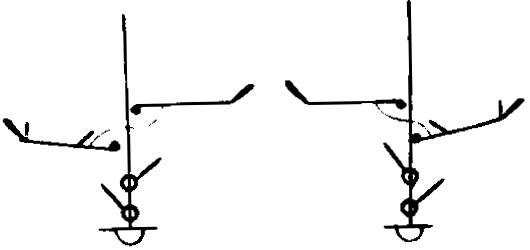 |
| Cross behind 2nd open sideways
|
the same before
|
| the same
|
the same
 |
TABLE of Coupees |
|
| Cross behind going sideways 2nd open.
|
the same
 |
| the same 2nd waving.
|
Open sideways 2nd cross behind.
 |
| the same before.
|
Forwards 2nd joyn’d.
 |
the same backwards.
 |
Forwards 2nd inclosed. behind.
 |
| Open sideways 2nd joyn’d.
|
Another
|
| Open sideways 2nd inclosed behind.
|
the same before.
|
TABLE of Coupees |
|
| Crossed before going sideways 2nd joyn’d
|
Another
|
| the same crossed behind
|
Another
|
Beat behind and beat before
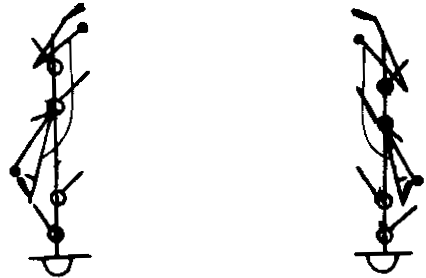 |
the same
 |
Beat behind 2nd inclosed behind
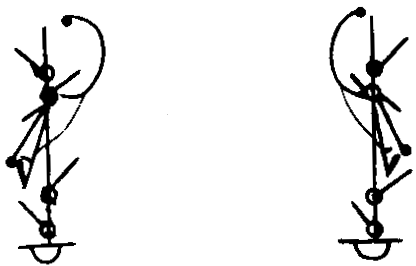 |
the same
 |
the same
 |
Beat before 2nd forwards
 |
the same
 |
Beat open sideways 2nd passing before open outwards
 |
TABLE of Coupees. |
|
Beat on the ankle and both open sideways
 |
the same
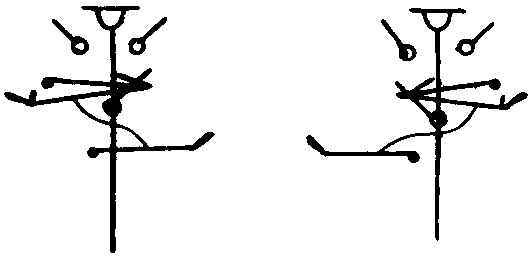 |
Cross before quarter turn and 2nd open sideways
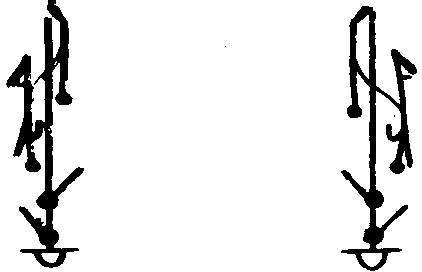 |
Open sideways: turn: 2nd crossed before
 |
Open sideways: turn: 2nd open: sideways
 |
the same
 |
the same
 |
Open sideways turn: 2nd Crossed behind
 |
Open sideways turn: 2nd crossed before
 |
Another
 |
Another crossed before
 |
1st open sideways turn: 2nd open: sideways
 |
TABLE of Coupees |
|
the same
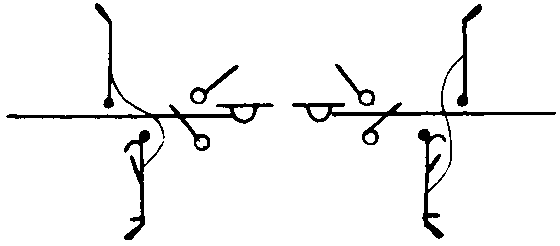 |
the same
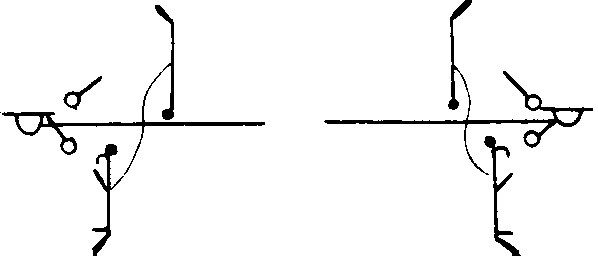 |
Forwards turning
 |
Another
|
Forwards turning 2nd joyned
 |
Another
 |
Forwards turning 2nd inclosed. behind
 |
Forwards turning
|
| Crossed behind turning 2nd forwards
|
Forwards turning
|
| Crossed behind turning 2nd forwards
|
Backwards turning
 |
TABLE of Coupees. |
|
Another
 |
half turn 2nd open outwards
 |
half turn 2nd backwards
 |
half turn forwards
 |
Another
 |
Turn: open: & cross: behind: 2nd open outwards
 |
| Open sideways; turn: 2nd open sideways
|
the same
 |
the same
 |
Open turn with a beat before: 2nd open sideways
 |
Another 2nd crossed behind
 |
Beat behind turn 2nd inclosed behind
 |
TABLE of Coupees. |
|
the same
 |
Beat behind turn 2nd open sideways
 |
Both open sideways
 |
the same
|
Cross before turn 2nd open sideways
 |
Forwards turning
 |
Cross before turn 2nd open sideways
 |
the same
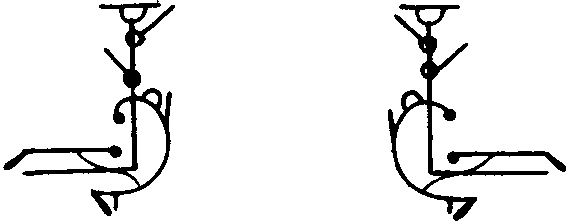 |
3 quarter turn 2nd open outwards
 |
Another whole turn
 |
Turn sideways 2nd turn going behind and opening sideways
 |
Whole turn 2nd open sideways
 |
TABLE of Bouree’s. |
|
the same.
 |
Another the last open sideways
 |
the same.
 |
the same.
 |
the same
 |
the same 3d. cross’d before.
 |
the same.
 |
the same.
 |
1st circular before fall behind; 2d inclosed: behind
3d forwards.
 |
1st circular sideways; the 2d & 3 same as before
 |
| Sideways
|
Another.
|
TABLE of Bouree’s. |
|
| 1st & 2d open 3rd inclosed behind.
|
the same.
 |
the same.
 |
behind going sideways.
|
| before going sideways.
|
Another
|
the same.
 |
before & behind sideways.
|
the same.
 |
behind & before sideways.
|
the same.
 |
behind going sideways.
|
TABLE of Bouree’s. |
|
the same.
 |
1st behind 2d Waving & open sideways 3d inclosed.
behind.
|
1st open sideways 2d cross behind 3d open sideways.
 |
the same 2d cross’d before
|
1st forwards: 2d inclosed behind 3d forwards
 |
1st open sideways, 2d joyn’d, 3d open sideways.
|
1st open sideways, 3d inclosed. behind, 3d forwards
 |
1st cross’d before 2d. joyn’d 3d before.
|
| the same cross’d behind.
|
1st cross’d before, 2d joyn’d, 3d open sideways.
|
| the same cross’d behind
|
1st beat behind, 2d beat before, 3d forwards.
 |
TABLE of Bouree’s |
|
1st beat behind, 2d inclosed. behind, 3d forwards.
 |
the same.
 |
beat before, 2d forwards, 3d inclosed. behind.
 |
1st beat sideways, 2d open & the 3d. inclosed:
behind.
 |
the same.
 |
quarter turn sideways before.
 |
before & behind, quarter turn sideways.
 |
1st open sideways, quarter turn: 2d cross’d before,
3d open sideways.
 |
the same cross’d behind.
 |
quarter turn, 1st & 2d open, 3d inclosed. behind.
 |
the same.
 |
the same.
 |
TABLE of Bouree’s |
|
| forward turning
|
Another
|
| 1st forwards: turn: 2d inclosed: behind 3d forwards.
|
forward turning
|
1st behind: turning: 2d & 3d forward.
 |
forward turning.
|
1st behind turning: 2d open: & inclosed. behind:
3d forwards.
 |
backwards turning
|
Another
 |
1st open inwards turn: 2d open inclosed behind: 3d
forwards.
 |
the 1st open inwards turn 2d. open sideways. 3d inclosed
behind.
 |
forwards half turn
 |
TABLE of Bouree’s |
|
forwards half turn.
 |
1st open outwards & back, turn 2nd open outwards,
inclosed behind 3rd forwards.
 |
1st open, turn 2nd open, 3rd inclosed behind.
 |
the same.
 |
the same.
 |
1st beat before turn & open sideways, 2nd open,
3rd inclosed. behind.
 |
the same.
 |
1st beat before turn, 2nd inclosed behind, 3rd cross’d
before.
 |
the same.
 |
1st beat behind, turn 2nd & 3rd open sideways.
 |
1st open turn 2nd open 3rd inclosed.
 |
the same.
 |
TABLE of Bouree’s |
|
| half turn sideways.
|
the same before and behind.
|
forwards half turn.
 |
1st cross’d before turn 2nd open sideways & 3rd
joyn’d.
 |
the same sideways before.
 |
the same before and behind.
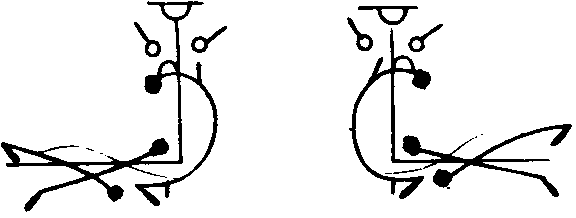 |
1st open & 3 quarter turn, 2rd joyn’d with quarter
turn 3rd forward.
 |
1st open half turn 2nd beat behind turn half 3rd cross’d
behind.
 |
before and behind turn a whole turn.
 |
1st cross’d before half turn, 2nd quarter turn, 3rd
joyn’d.
 |
the same 3rd sideways.
 |
1st beat behind half turn, 2nd quarter turn, 3rd open
sideways.
 |
TABLE of Bounds |
|
fowards 2nd joyn’d open.
 |
the same backwards.
 |
forwards 2nd inclosed behind.
 |
the same backwards inclosed before.
 |
| open sideways 2nd joyn’d up.
|
the same inclosed behind.
 |
| Cross’d before 2nd sideways joyn’d up.
|
Illustration: the same.
|
| the same cross’d behind.
|
forwards quarter turn 2nd open outwards.
 |
Cross’d behind quarter turn 2nd open outwards.
 |
backwards quarter turn 2nd open outwards.
 |
TABLE of Bounds |
|
half turn 2nd open backwards.
 |
forwards turning
 |
Another
 |
behind turning 2nd open outwards.
 |
open sideways turn 2nd open outwards
 |
forwards turn.
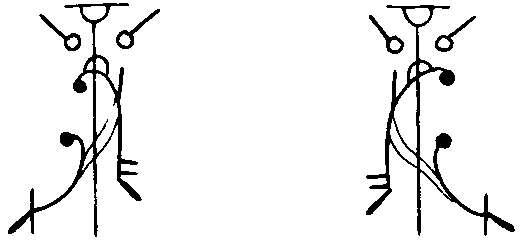 |
3 quarter turn 2nd behind up
 |
the same.
 |
Another.
 |
Whole turn 2nd open outwards.
 |
Another 2nd inclosed behind.
 |
on both feet a whole turn.
 |
TABLE of Contretemps |
|
forwards open & bound on the same foot which is
called Balonne.
 |
Another the sinking of the bound taken from the instep.
 |
backwards 2nd inclosed behind.
 |
beat before inclosed behind 2nd forwards.
 |
backwards 2nd open sideways.
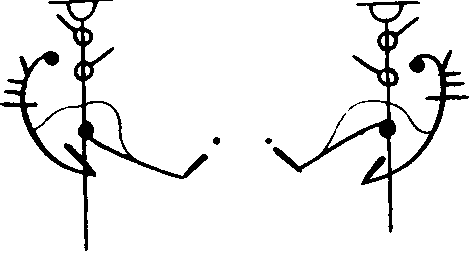 |
sideways 2nd cross’d before.
 |
| Another 2nd cross’d behind.
|
sideways 1st cross’d before 2nd open sideways.
|
| the same from another position.
|
the same.
 |
beat before cross’d behind & open sideways.
 |
open 2nd cross’d behind.
 |
TABLE of Contretemps |
|
| open 2nd cross’d before.
|
open sideways waving 2nd cross’d behind.
 |
open sideways, 2nd cross’d behind.
 |
forwards 2nd joyn’d.
 |
backwards and joyn’d
 |
Rigandon step.
Springing open fall in the same position 2nd the same without spring.  |
the same.
 |
open sideways 2nd joyn’d.
 |
| Another.
|
open sideways 2nd inclosed behind.
 |
| the same inclosed behind.
|
beat sinking behind spring forward cross’d 2nd open
sideways.
 |
TABLE of Contretemps |
|
cross’d before turn 2nd open sideways.
 |
open sideways turn 2nd cross’d before.
 |
the same cross’d behind.
 |
beat on the instep turn and inclosed behind and forwards.
 |
open sideways turn & cross’d before.
 |
Another cross’d before.
 |
open sideways turn & cross’d behind.
 |
the same.
 |
forwards turning.
 |
Another.
 |
| Another.
|
backwards turn.
 |
TABLE of Contretemps |
|
beat on the instep burn open sideways 2nd open also.
 |
half turn 2nd backwards.
 |
forwards turning
 |
Another.
 |
turning 2nd inclosed both.
 |
open sideways turning 2nd cross’d behind.
 |
open turn sinking behind to hop open sideways 2nd cross’d
behind.
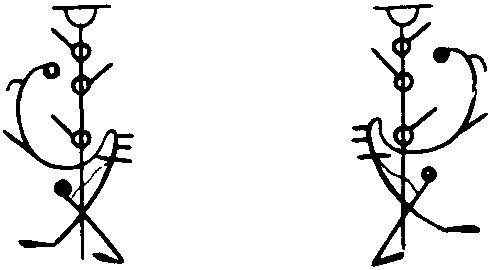 |
open turn sinking behind to hop forwards 2nd also forwards.
 |
the same with a half turn.
 |
beat behind turn and forwards.
 |
open sideways turn 2nd cross’d.
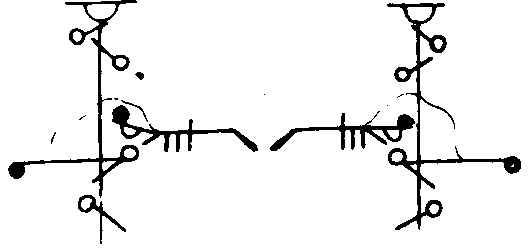 |
the same.
|
TABLE of Contretemps. |
|
open turn: half turn the last back: turn: quarter turn
 |
cross’d before: half turn 2nd open.
|
beat before & inclosed behind 2nd forwards turning
quarter turn
 |
forwards turn half turn
 |
cross’d before turn: 2nd open sideways.
 |
the same.
 |
half turn circular, sinking to bound turn: left open.
 |
Another
 |
beat on the ankle half turn & forwards.
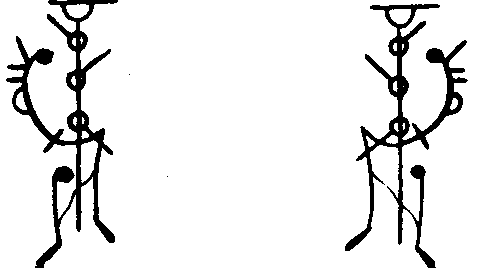 |
open turn: 3 quarter turn 2nd backwards.
 |
a whole turn 2nd beat behind.
 |
beat behind: whole turn forwards the last.
 |
TABLEofChassees and Falling steps. |
|
Drive without springing.
 |
the same.
 |
beaten Chassee behind.
 |
sideways turn.
 |
Chassee forwards with falling step.
 |
the same
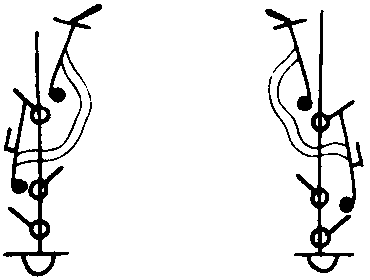 |
a falling steps open both feet and rise on the 2nd.
 |
Another 1st drives the 2nd and batone.
 |
1st drives the 2nd springing. 2nd driv the 3rd by a
falling step.
 |
the same sideways without sinking.
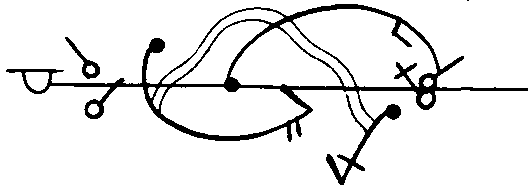 |
TABLEofPiroüettes. |
|||
open cross’d behind & turn on the toes half turn.
 |
the same cross’d before.
 |
||
|
a whole turn open outwards.
 |
||
open inwards.
 |
a turn behind open outwards.
open inwards.
 |
||
a whole turn open outwards.
 |
open inward.
 |
||
2 turns open outward.
 |
open inward.
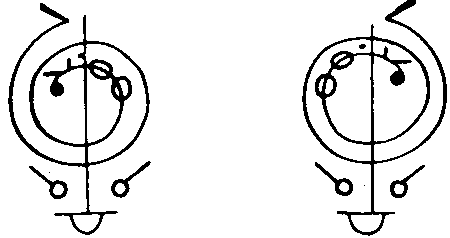 |
||
TABLE of Piroüettes. |
|
beat before behind and before half a turn outwards.
 |
the same inwards.
 |
Another outwards.
 |
open a half turn inwards circular & beating on
the instep.
 |
beat before behind & before a whole turn outward.
 |
the same inward.
 |
Another outward.
 |
beat before & behind one turn inward open one leg
outward.
 |
beat before & behind 2nd each & end inclosed
behind a whole turn outward.
 |
the same inward.
 |
beat behind & before twice each one turn outward.
 |
open circular inwards beat before behind & before
one turn outward.
 |
a TABLEofCapers and half Capers. |
|
half caper forwards or a beaten bound.
 |
the same backwards.
 |
half Caper in moving or a beaten hop.
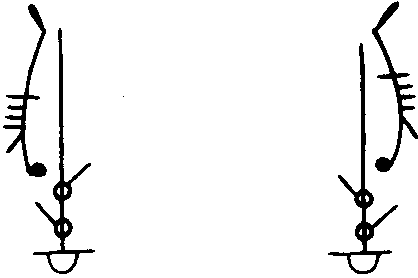 |
the same backwards.
 |
Another forwards.
 |
a Caper Chassee forwards.
 |
the same backwards.
 |
Another.
 |
a beaten Sissonne.
 |
the same backwards.
 |
TABLE of Capers. |
|
Another the last circular.
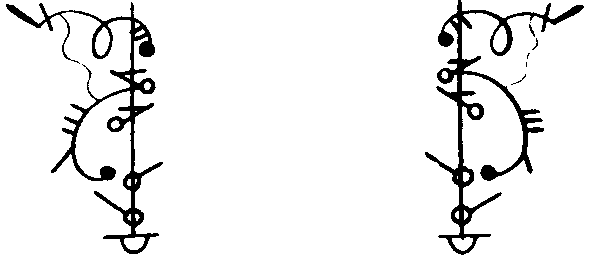 |
an upright Caper in the same position.
 |
the same the right foot falling behind.
 |
the same turning quite round.
 |
| half Caper turning quarter turn.
|
Another.
|
Another.
 |
Another with a half turn.
 |
Another.
 |
a side caper with a whole turn.
 |
a half Caper a whole turn.
 |
a back Caper.
 |
a TABLEofEntrechats or Cross Capers |
|
a half Entrechat open the leg cross before and fall
behind.
 |
another beat and sinking on the instep cross behind
& return before.
 |
Entrechat of 3 and move forwards; the foot the ended
open.
 |
of 4 & return on the same position.
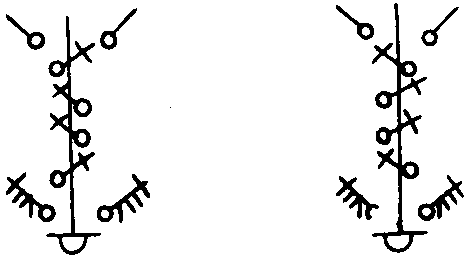 |
the same moving sideways.
 |
of 3 moving sideways, the foot ending behind moving
sideways.
|
an Entrechat of v[5] in the same place.
 |
an Entrechat of 5 forwards.
 |
the same.
 |
of 4 turning and falling in the same position.
 |
TABLE of Waving Steps |
|||
forwards.
 |
backwards.
 |
sideways.
|
beat behind open before waving.
 |
forwards and after wave the heel.
 |
the same with the toe.
 |
a Pirouette waving on the Toes and heels alternatively.
 |
|
Spring and wave one foot.
 |
with both feet waving.
 |
a whole turn waving as above.
 |
|
spring forwards waving both feet.
 |
the same backwards.
 |
half Coupee, afterwards wave the heel then 2 toes and
the heel, end inclosed.
 |
|
a Contretemps waving, then wave the other foot, first
the Toe and then the heel. end as before.
 |
Finis. |
||
aSuplement of Steps. |
|||
| Minuet step.
|
French minuet step.
|
with a fleuret.
 |
with a Bound.
 |
| sideways behind.
|
before and behind.
|
sideways with a fleuret.
|
to Ballance.
 |
| the hope or Contretemps forwards in the minuet time.
|
the hop backwards.
 |
a step in the Minuet.
 |
the same sideways.
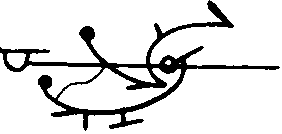 |
| boree with a bound.
|
a Contretemps with a bound.
|
a sissone with a Contretemps.
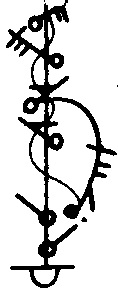 |
a Contretemps with a Slide.
 |
| These four last steps are all of them in the Rigandon of Mr. Isaac’s, and give a particular grace to the dance which the common way of performing them would not do; and it is to Mr. Isaac we owe the so frequent use of them here since they are seldom, or ever found, in any other Dances whatsoever. | |||
Common Time, is used in Gavots, Galliards, Bouree’s, Rigandons, Jiggs, and Canaries.
Triple Time, is made use of in Courants, Sarabands, Chaconnes, Passacailes, Minuets, and Passe-Pieds.
And Quadruple Time, is made use of in slow Tunes, as appears by the second Tune in the following Plate, and the Tunes called Loures.
To Tunes of Common or Triple Time, a Step is put for each Barr or Measure; and to Tunes of Quadruple Time, you must put two.
It is to be observ’d nevertheless, that in Courant Movements, two Steps are put to each Barr or Measure; the first of which takes up two parts in three of the Measure, and the second takes up the third part; and in the Minuet, one Step is put to two Barrs or Measures.
The Barrs or Measures in Dances, must be marked in like manner with those in Musick, viz. with little Barrs crossing the Tract, which are to agree with those of the Tune.Example.

You will understand by the following Examples, how each Step agrees with the Tune to which they are composed.
Common time

Triple time

Example of Steps which doe agree with the Measure of Common or Triple
Time.

Quadruple Time.

Lovres

Example of Steps agreeing with Quadruple Time or Louves.
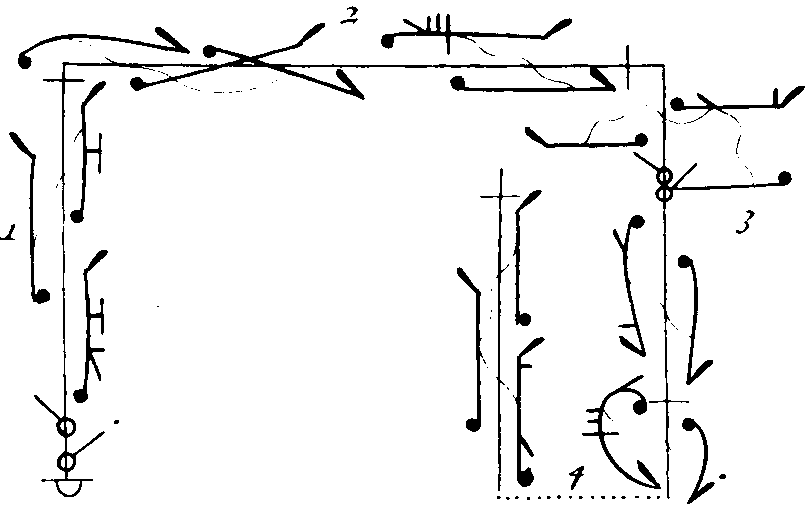
If it happens that you have occasion to put more Steps in a Measure, than are in the foregoing Examples, the following Rules must be observed.
If, for Example, you would in a Measure of Common Time, or half a Measure of Quadruple Time, which is the same thing, put a Fleuret and a Bound; the three Steps composing the Fleuret, must have a double Tie to join them, and which will shew their Motion to be as swift again, as if there had been but one; the Bound also must be joined to the Fleuret with a single Tie only; by which you will know, that these two Steps are in Effect but one.
Examples.


If you would put the same Step in a Measure of Triple Time, the two first Steps of the Fleuret must only have a double Tie.

When in Dancing some Measures of the Tune, are to be let slip, whether in the beginning or middle of the Dance, it must be mark’d in the following manner, vis. by a little Stroke crossing obliquely the Tract, and as many of them are to be mark’d, as there are Barrs to be let slip; and in describing a half Measure, half the Stroke only must be mark’d.
Three Measures and a half.

The same Stroke longways, parallel with the Tract, is equivalent to four of the foregoing Strokes, and takes up four Measures of the Tune.
Fourteen Measures.

For a Time, half Time, or quarter Time, &c. they may be mark’d in the same manner as they are in Musick.
A quarter Time. A half Time. A Time.

In Tunes, which begin with odd Notes, as Gavots, Chaconnes, Jiggs, loures, Bouree’s, &c. the foregoing Marks must be made Use of in the beginning of the Tract.
The Letters of the Alphabet, which are plac’d upon the Steps in the following Example, and which are also plac’d over the Notes of the Tune, demonstrate the Time or Cadence of a Dance.

A regular Figure, is when two or more Dancers move contrarily, the one to the Right, and the other to the Left.
A regular Figure.

An irregular Figure, is when two Dancers move together, both in the same Figure, on the same side.
An irregular Figure.
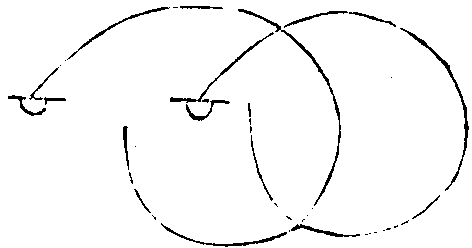
By the Mark representing the Presence of the Body, you will distinguish the Tract for the Man, from that of the Woman; in that for the Man, the half Circle is single, and that for the Woman, is double. The Distinction for two Men, or two Women Dancing together, is known by a Point plac’d in the middle of the half Circle of one of them, that wherein the Point is, representing the Tract for the Woman Side.
| The Tract for a Man.
|
The Tract for a Woman.
|
Tracts for two Men.
 |
Tracts for two Women.
 |
If a Number of Dancers figure together, the Mark for the placing the Body will not be sufficient to distinguish them, (as in a Dance for eight:) On this Occasion therefore, you may make Use of Letters, of which AA may represent two which figure together. BB two others. CC two more, and DD the other two; each of which, will also be distinguish’d by there figuring, and which the following Example will demonstrate.

I shall now add, that when in Dancing, several Steps are to be perform’d in the same place, the Tract is then to be respected only as the Conductor of the Step, and not in Relation to the Figure; but where the Steps move continually from one place to another, then the Tract is to be observ’d, not only for the Description of the Steps, but also for the Figure of the Dance. Place your self then where the beginning of the Tract directs, and observe whether the Figure be streight, diametrical, circular, or oblique, whether it be forwards, backwarks, or sideways, if to the right, or to the left; all which I have already demonstrated in the foregoing Pages; then having learnt the Tune, which must be prick’d down on the Top of each Page, add the Steps to the Tune, as has been already shewn, moving in the Figure as is described on the Paper. When it happens that the Tract or Tracts cross one another, the Steps on the one, must leave a sufficient Breach, for the describing the Steps; on the other, to avoid Confusion.
To give the right Hand.
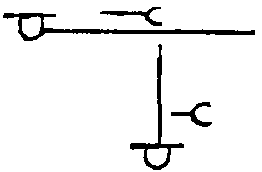 |
To give the left Hand
 |
To give both Hands.
 |
When you have thus given one Hand or both, you are not to quit Hands, till you find the same Marks cut through with another little Stroke, which shews, that in that place the Hands are to let go.
To let go one Hand.

To give one Hand. |
To let go both Hands.

To give both Hands. |
The Arm is represented by the Letters ABC, of which A represents the Shoulder, B the Elbow, and C the Wrist.
| The Arm streight
|
The Wrist bent.
|
The Arm bent.
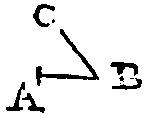 |
The Arm quite before.
 |
Both Arms open.
 |
The left Arm open, the right bent at Elbow.
 |
Both arms open.
 |
The right Arm open, and the left quite closed.
 |
I shall not pretend to make a long Disquisition on the Motion of the Arms, but shall only add, that as there are three Movements from the Waste downwards, fo there are also three Movements in the Arms, which have a Correspondence, and are agreeing with them below, viz. that of the Wrist, has Relation to the Heel; that of the Elbow, to the Knee, and that of the Shoulder, or the whole Arm, to the Thigh.
You will know when the Arm moves by an arch’d Line, mark’d C D, drawn from that which represents the end of the Arm, which shews the Figure the Wrist makes in moving, as from C to D.



![]()
The Movements of the Arms are to be perform’d two ways, upwards or downwards; upwards from the Position of the Arm below, or downwards from the Position above.
The Motion of the Arm upwards, is when the Arm, which is open or extended, closes (in approaching) to the Body ascending, and the Motion of the Arm downwards, is when the Arm, which is clos’d, opens or extends it self descending.
| The Motion of the Wrist upwards.
|
The Motion of the Elbow upwards.
|
The Motion of the whole Arm upwards.
|
The Motion of the Wrist downwards.
|
The motion of the Elbow downwards.
 |
The Motion of the whole Arm downwards.
 |
| The Wrist moving round upwards.
|
The Elbow moving round upwards.
|
The whole Arm moving round upwards.
|
The Wrist moving round downwards.
|
The Elbow moving round downwards.
|
The whole Arm moving round downwards.
|
| The Wrist moving round downwards.
|
The Elbow moving round downwards.
 |
The whole Arm moving round downwards.
 |
Double Movement of the Wrist upwards and downwards.
|
Double Movement of the Elbow upwards and downwards.
 |
Double Movement of the whole Arm upwards and downwards.
 |
The Arms may either move both together, or one after the other; you will know when the Arms are to move together, by a Line or Tie drawn from the one to the other; and when there is no Tie, they are then to move one after the other.
The Arms may either move alike with the same Movement, as when both Arms either open or extend themselves together, or close, or approach each other at the same time.
Or they may move contrary one to the other, when the one opens, and the other closes.
Both Arms moving together with the same Motion.
 |
Both Arms moving together with a contrary Movements.
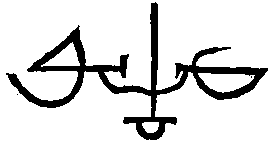 |
Both Arms moving one after the other, first the right,
and then the left.
 |
On the Top of each Page, on which your Dance is describ’d, you must prick down as many Barrs of the Tune, as there are Barns or Measures in the Dance.
Altho’ the Tract serves generally for the explaining the Figure of the Dance, yet it often happens that many Steps are to be perform’d in the same Place, and then (as I have shewn before) the Tract is to have regard only to the Steps. This Tract is only a borrow’d Tract, and which may be drawn any way, as shall be most convenient. As for Example, from A to B, altho’ the Tract is drawn out in length from A to B, the Dancer nevertheless removes not from A, which may also be well understood by the Steps, which are from A to B, which can only be perform’d in the same place.

You must observe at the end of each Page, the place where the Dancer finishes, and to what part of the Room the Face directs, by which means you will readily know where to place the beginning of the Tract in the following Page ; and so continue from Page to Page, to the end of the Dance.
But if in the beginning of a Page, two Dancers should happen to be close together, and some Steps to be perform’d in the same place; which Steps cannot be conveniently described, neither on one side, or the other, and that the Closeness of the Dancers, will not admit of advancing of the Tracts, one towards the other; you must then be oblig’d, instead of placing the Tracts at C D, to retire as far back as will be necessary to describe the Steps, so that the Steps may end at C D.

Or else the contrary may be done, by placing the beginning of the Steps at C D; and instead of describing the Steps one towards the other, they must Separate, as from C to E, and D to F.
You will find these are perform’d without the Dancers moving out of their Places; and both these Examples are equally good, in considering only which agrees best with the Figure of the Dance that follows.

If in the Dances in the second Volume, you find some of the Steps longer than others, you must have no Regard to them, as to their Length in the Description of them, but judge of their Extension by the Distance of Positions, (as I have already shewn in the Termination of the Steps, in their Positions;) so that you are not to conclude any thing from the Length or Shortness of Steps.
End of the Project Gutenberg EBook of Orchesography, by John Weaver
*** END OF THIS PROJECT GUTENBERG EBOOK ORCHESOGRAPHY ***
***** This file should be named 9454-h.htm or 9454-h.zip *****
This and all associated files of various formats will be found in:
http://www.gutenberg.org/9/4/5/9454/
Produced by Tobin Richard, Debra Storr, Greg Lindahl and
PG Distributed Proofreaders
Updated editions will replace the previous one--the old editions
will be renamed.
Creating the works from public domain print editions means that no
one owns a United States copyright in these works, so the Foundation
(and you!) can copy and distribute it in the United States without
permission and without paying copyright royalties. Special rules,
set forth in the General Terms of Use part of this license, apply to
copying and distributing Project Gutenberg-tm electronic works to
protect the PROJECT GUTENBERG-tm concept and trademark. Project
Gutenberg is a registered trademark, and may not be used if you
charge for the eBooks, unless you receive specific permission. If you
do not charge anything for copies of this eBook, complying with the
rules is very easy. You may use this eBook for nearly any purpose
such as creation of derivative works, reports, performances and
research. They may be modified and printed and given away--you may do
practically ANYTHING with public domain eBooks. Redistribution is
subject to the trademark license, especially commercial
redistribution.
*** START: FULL LICENSE ***
THE FULL PROJECT GUTENBERG LICENSE
PLEASE READ THIS BEFORE YOU DISTRIBUTE OR USE THIS WORK
To protect the Project Gutenberg-tm mission of promoting the free
distribution of electronic works, by using or distributing this work
(or any other work associated in any way with the phrase "Project
Gutenberg"), you agree to comply with all the terms of the Full Project
Gutenberg-tm License available with this file or online at
www.gutenberg.org/license.
Section 1. General Terms of Use and Redistributing Project Gutenberg-tm
electronic works
1.A. By reading or using any part of this Project Gutenberg-tm
electronic work, you indicate that you have read, understand, agree to
and accept all the terms of this license and intellectual property
(trademark/copyright) agreement. If you do not agree to abide by all
the terms of this agreement, you must cease using and return or destroy
all copies of Project Gutenberg-tm electronic works in your possession.
If you paid a fee for obtaining a copy of or access to a Project
Gutenberg-tm electronic work and you do not agree to be bound by the
terms of this agreement, you may obtain a refund from the person or
entity to whom you paid the fee as set forth in paragraph 1.E.8.
1.B. "Project Gutenberg" is a registered trademark. It may only be
used on or associated in any way with an electronic work by people who
agree to be bound by the terms of this agreement. There are a few
things that you can do with most Project Gutenberg-tm electronic works
even without complying with the full terms of this agreement. See
paragraph 1.C below. There are a lot of things you can do with Project
Gutenberg-tm electronic works if you follow the terms of this agreement
and help preserve free future access to Project Gutenberg-tm electronic
works. See paragraph 1.E below.
1.C. The Project Gutenberg Literary Archive Foundation ("the Foundation"
or PGLAF), owns a compilation copyright in the collection of Project
Gutenberg-tm electronic works. Nearly all the individual works in the
collection are in the public domain in the United States. If an
individual work is in the public domain in the United States and you are
located in the United States, we do not claim a right to prevent you from
copying, distributing, performing, displaying or creating derivative
works based on the work as long as all references to Project Gutenberg
are removed. Of course, we hope that you will support the Project
Gutenberg-tm mission of promoting free access to electronic works by
freely sharing Project Gutenberg-tm works in compliance with the terms of
this agreement for keeping the Project Gutenberg-tm name associated with
the work. You can easily comply with the terms of this agreement by
keeping this work in the same format with its attached full Project
Gutenberg-tm License when you share it without charge with others.
1.D. The copyright laws of the place where you are located also govern
what you can do with this work. Copyright laws in most countries are in
a constant state of change. If you are outside the United States, check
the laws of your country in addition to the terms of this agreement
before downloading, copying, displaying, performing, distributing or
creating derivative works based on this work or any other Project
Gutenberg-tm work. The Foundation makes no representations concerning
the copyright status of any work in any country outside the United
States.
1.E. Unless you have removed all references to Project Gutenberg:
1.E.1. The following sentence, with active links to, or other immediate
access to, the full Project Gutenberg-tm License must appear prominently
whenever any copy of a Project Gutenberg-tm work (any work on which the
phrase "Project Gutenberg" appears, or with which the phrase "Project
Gutenberg" is associated) is accessed, displayed, performed, viewed,
copied or distributed:
This eBook is for the use of anyone anywhere at no cost and with
almost no restrictions whatsoever. You may copy it, give it away or
re-use it under the terms of the Project Gutenberg License included
with this eBook or online at www.gutenberg.org
1.E.2. If an individual Project Gutenberg-tm electronic work is derived
from the public domain (does not contain a notice indicating that it is
posted with permission of the copyright holder), the work can be copied
and distributed to anyone in the United States without paying any fees
or charges. If you are redistributing or providing access to a work
with the phrase "Project Gutenberg" associated with or appearing on the
work, you must comply either with the requirements of paragraphs 1.E.1
through 1.E.7 or obtain permission for the use of the work and the
Project Gutenberg-tm trademark as set forth in paragraphs 1.E.8 or
1.E.9.
1.E.3. If an individual Project Gutenberg-tm electronic work is posted
with the permission of the copyright holder, your use and distribution
must comply with both paragraphs 1.E.1 through 1.E.7 and any additional
terms imposed by the copyright holder. Additional terms will be linked
to the Project Gutenberg-tm License for all works posted with the
permission of the copyright holder found at the beginning of this work.
1.E.4. Do not unlink or detach or remove the full Project Gutenberg-tm
License terms from this work, or any files containing a part of this
work or any other work associated with Project Gutenberg-tm.
1.E.5. Do not copy, display, perform, distribute or redistribute this
electronic work, or any part of this electronic work, without
prominently displaying the sentence set forth in paragraph 1.E.1 with
active links or immediate access to the full terms of the Project
Gutenberg-tm License.
1.E.6. You may convert to and distribute this work in any binary,
compressed, marked up, nonproprietary or proprietary form, including any
word processing or hypertext form. However, if you provide access to or
distribute copies of a Project Gutenberg-tm work in a format other than
"Plain Vanilla ASCII" or other format used in the official version
posted on the official Project Gutenberg-tm web site (www.gutenberg.org),
you must, at no additional cost, fee or expense to the user, provide a
copy, a means of exporting a copy, or a means of obtaining a copy upon
request, of the work in its original "Plain Vanilla ASCII" or other
form. Any alternate format must include the full Project Gutenberg-tm
License as specified in paragraph 1.E.1.
1.E.7. Do not charge a fee for access to, viewing, displaying,
performing, copying or distributing any Project Gutenberg-tm works
unless you comply with paragraph 1.E.8 or 1.E.9.
1.E.8. You may charge a reasonable fee for copies of or providing
access to or distributing Project Gutenberg-tm electronic works provided
that
- You pay a royalty fee of 20% of the gross profits you derive from
the use of Project Gutenberg-tm works calculated using the method
you already use to calculate your applicable taxes. The fee is
owed to the owner of the Project Gutenberg-tm trademark, but he
has agreed to donate royalties under this paragraph to the
Project Gutenberg Literary Archive Foundation. Royalty payments
must be paid within 60 days following each date on which you
prepare (or are legally required to prepare) your periodic tax
returns. Royalty payments should be clearly marked as such and
sent to the Project Gutenberg Literary Archive Foundation at the
address specified in Section 4, "Information about donations to
the Project Gutenberg Literary Archive Foundation."
- You provide a full refund of any money paid by a user who notifies
you in writing (or by e-mail) within 30 days of receipt that s/he
does not agree to the terms of the full Project Gutenberg-tm
License. You must require such a user to return or
destroy all copies of the works possessed in a physical medium
and discontinue all use of and all access to other copies of
Project Gutenberg-tm works.
- You provide, in accordance with paragraph 1.F.3, a full refund of any
money paid for a work or a replacement copy, if a defect in the
electronic work is discovered and reported to you within 90 days
of receipt of the work.
- You comply with all other terms of this agreement for free
distribution of Project Gutenberg-tm works.
1.E.9. If you wish to charge a fee or distribute a Project Gutenberg-tm
electronic work or group of works on different terms than are set
forth in this agreement, you must obtain permission in writing from
both the Project Gutenberg Literary Archive Foundation and Michael
Hart, the owner of the Project Gutenberg-tm trademark. Contact the
Foundation as set forth in Section 3 below.
1.F.
1.F.1. Project Gutenberg volunteers and employees expend considerable
effort to identify, do copyright research on, transcribe and proofread
public domain works in creating the Project Gutenberg-tm
collection. Despite these efforts, Project Gutenberg-tm electronic
works, and the medium on which they may be stored, may contain
"Defects," such as, but not limited to, incomplete, inaccurate or
corrupt data, transcription errors, a copyright or other intellectual
property infringement, a defective or damaged disk or other medium, a
computer virus, or computer codes that damage or cannot be read by
your equipment.
1.F.2. LIMITED WARRANTY, DISCLAIMER OF DAMAGES - Except for the "Right
of Replacement or Refund" described in paragraph 1.F.3, the Project
Gutenberg Literary Archive Foundation, the owner of the Project
Gutenberg-tm trademark, and any other party distributing a Project
Gutenberg-tm electronic work under this agreement, disclaim all
liability to you for damages, costs and expenses, including legal
fees. YOU AGREE THAT YOU HAVE NO REMEDIES FOR NEGLIGENCE, STRICT
LIABILITY, BREACH OF WARRANTY OR BREACH OF CONTRACT EXCEPT THOSE
PROVIDED IN PARAGRAPH 1.F.3. YOU AGREE THAT THE FOUNDATION, THE
TRADEMARK OWNER, AND ANY DISTRIBUTOR UNDER THIS AGREEMENT WILL NOT BE
LIABLE TO YOU FOR ACTUAL, DIRECT, INDIRECT, CONSEQUENTIAL, PUNITIVE OR
INCIDENTAL DAMAGES EVEN IF YOU GIVE NOTICE OF THE POSSIBILITY OF SUCH
DAMAGE.
1.F.3. LIMITED RIGHT OF REPLACEMENT OR REFUND - If you discover a
defect in this electronic work within 90 days of receiving it, you can
receive a refund of the money (if any) you paid for it by sending a
written explanation to the person you received the work from. If you
received the work on a physical medium, you must return the medium with
your written explanation. The person or entity that provided you with
the defective work may elect to provide a replacement copy in lieu of a
refund. If you received the work electronically, the person or entity
providing it to you may choose to give you a second opportunity to
receive the work electronically in lieu of a refund. If the second copy
is also defective, you may demand a refund in writing without further
opportunities to fix the problem.
1.F.4. Except for the limited right of replacement or refund set forth
in paragraph 1.F.3, this work is provided to you 'AS-IS', WITH NO OTHER
WARRANTIES OF ANY KIND, EXPRESS OR IMPLIED, INCLUDING BUT NOT LIMITED TO
WARRANTIES OF MERCHANTABILITY OR FITNESS FOR ANY PURPOSE.
1.F.5. Some states do not allow disclaimers of certain implied
warranties or the exclusion or limitation of certain types of damages.
If any disclaimer or limitation set forth in this agreement violates the
law of the state applicable to this agreement, the agreement shall be
interpreted to make the maximum disclaimer or limitation permitted by
the applicable state law. The invalidity or unenforceability of any
provision of this agreement shall not void the remaining provisions.
1.F.6. INDEMNITY - You agree to indemnify and hold the Foundation, the
trademark owner, any agent or employee of the Foundation, anyone
providing copies of Project Gutenberg-tm electronic works in accordance
with this agreement, and any volunteers associated with the production,
promotion and distribution of Project Gutenberg-tm electronic works,
harmless from all liability, costs and expenses, including legal fees,
that arise directly or indirectly from any of the following which you do
or cause to occur: (a) distribution of this or any Project Gutenberg-tm
work, (b) alteration, modification, or additions or deletions to any
Project Gutenberg-tm work, and (c) any Defect you cause.
Section 2. Information about the Mission of Project Gutenberg-tm
Project Gutenberg-tm is synonymous with the free distribution of
electronic works in formats readable by the widest variety of computers
including obsolete, old, middle-aged and new computers. It exists
because of the efforts of hundreds of volunteers and donations from
people in all walks of life.
Volunteers and financial support to provide volunteers with the
assistance they need are critical to reaching Project Gutenberg-tm's
goals and ensuring that the Project Gutenberg-tm collection will
remain freely available for generations to come. In 2001, the Project
Gutenberg Literary Archive Foundation was created to provide a secure
and permanent future for Project Gutenberg-tm and future generations.
To learn more about the Project Gutenberg Literary Archive Foundation
and how your efforts and donations can help, see Sections 3 and 4
and the Foundation information page at www.gutenberg.org
Section 3. Information about the Project Gutenberg Literary Archive
Foundation
The Project Gutenberg Literary Archive Foundation is a non profit
501(c)(3) educational corporation organized under the laws of the
state of Mississippi and granted tax exempt status by the Internal
Revenue Service. The Foundation's EIN or federal tax identification
number is 64-6221541. Contributions to the Project Gutenberg
Literary Archive Foundation are tax deductible to the full extent
permitted by U.S. federal laws and your state's laws.
The Foundation's principal office is located at 4557 Melan Dr. S.
Fairbanks, AK, 99712., but its volunteers and employees are scattered
throughout numerous locations. Its business office is located at 809
North 1500 West, Salt Lake City, UT 84116, (801) 596-1887. Email
contact links and up to date contact information can be found at the
Foundation's web site and official page at www.gutenberg.org/contact
For additional contact information:
Dr. Gregory B. Newby
Chief Executive and Director
[email protected]
Section 4. Information about Donations to the Project Gutenberg
Literary Archive Foundation
Project Gutenberg-tm depends upon and cannot survive without wide
spread public support and donations to carry out its mission of
increasing the number of public domain and licensed works that can be
freely distributed in machine readable form accessible by the widest
array of equipment including outdated equipment. Many small donations
($1 to $5,000) are particularly important to maintaining tax exempt
status with the IRS.
The Foundation is committed to complying with the laws regulating
charities and charitable donations in all 50 states of the United
States. Compliance requirements are not uniform and it takes a
considerable effort, much paperwork and many fees to meet and keep up
with these requirements. We do not solicit donations in locations
where we have not received written confirmation of compliance. To
SEND DONATIONS or determine the status of compliance for any
particular state visit www.gutenberg.org/donate
While we cannot and do not solicit contributions from states where we
have not met the solicitation requirements, we know of no prohibition
against accepting unsolicited donations from donors in such states who
approach us with offers to donate.
International donations are gratefully accepted, but we cannot make
any statements concerning tax treatment of donations received from
outside the United States. U.S. laws alone swamp our small staff.
Please check the Project Gutenberg Web pages for current donation
methods and addresses. Donations are accepted in a number of other
ways including checks, online payments and credit card donations.
To donate, please visit: www.gutenberg.org/donate
Section 5. General Information About Project Gutenberg-tm electronic
works.
Professor Michael S. Hart was the originator of the Project Gutenberg-tm
concept of a library of electronic works that could be freely shared
with anyone. For forty years, he produced and distributed Project
Gutenberg-tm eBooks with only a loose network of volunteer support.
Project Gutenberg-tm eBooks are often created from several printed
editions, all of which are confirmed as Public Domain in the U.S.
unless a copyright notice is included. Thus, we do not necessarily
keep eBooks in compliance with any particular paper edition.
Most people start at our Web site which has the main PG search facility:
www.gutenberg.org
This Web site includes information about Project Gutenberg-tm,
including how to make donations to the Project Gutenberg Literary
Archive Foundation, how to help produce our new eBooks, and how to
subscribe to our email newsletter to hear about new eBooks.